Prins Bertils stig
This is perhaps Halmstad’s most beautiful walk. Generally following the coast, its 18 km meander by the sea from central Halmstad out to Tylösand and then on to leafy Möllegård.
Please note that due to maintenance, a shorter section of the trail is led below the Danish road. Prince Bertil's path is still open for lovely walks.
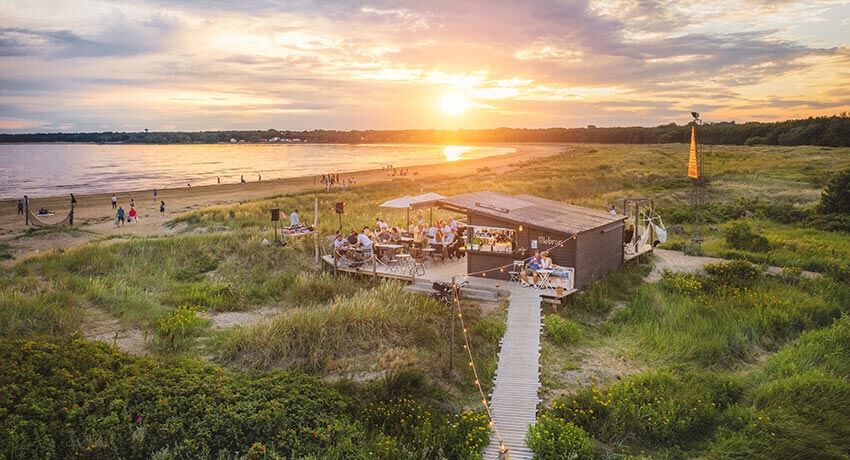
Restaurant lillebror on Västra stranden
Prince Bertil
Prince Bertil, who was the Duke of Halland, spent several summers here with Princess Lilian at a summer cottage in Tylösand.
Prince Bertil’s trail is a readily accessible trail that takes you on a journey through scenic countryside featuring everything from sand beaches, coastal forest, cliffs and old stone quarries to small-boat marinas and fishing bays. You pass places offering magnificent views, secluded bathing bays and mysterious spots that whisper tales of stone quarries and Viking battles.
The trail starts at Halmstad Castle in Halmstad City. Along the trail, there are trail posts, information boards, toilets, barbecue areas and benches for welcome rests. A large part of the trail is also accessible for prams and wheelchairs.
Joining and leaving the trail
At several points along Prince Bertil’s trail, public transport can take you back to your starting point. Check the Hallandstrafiken website for the bus stops and times that best suit your outing.
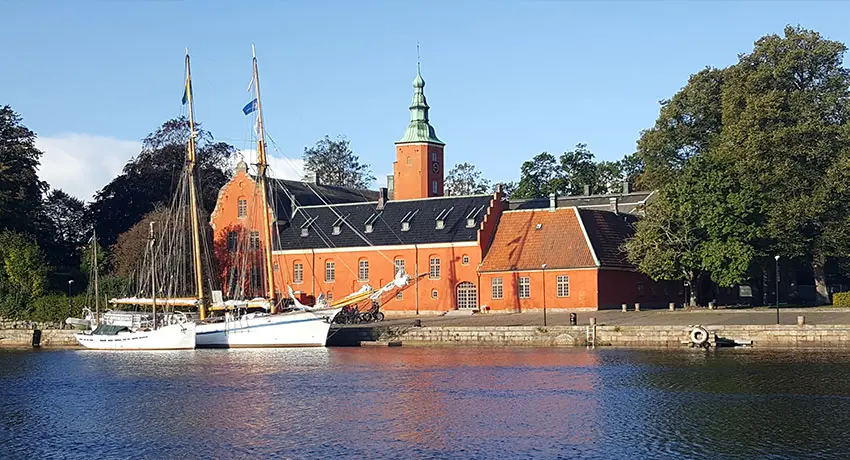
Halmstad Castle
Sights along the way
Halmstad Castle
Halmstad Castle was built as a palace for King Kristian IV of Denmark. Completed in 1619, it still retains its Renaissance style. This is where, for a full week, Kristian IV and King Gustav II Adolf of Sweden, celebrated payment of the final instalment of the sum for the return (to Sweden) of the port of Älvsborg. With the Second Treaty of Brömsebro in 1645 and The Treaty of Roskilde in 1658, the castle became Swedish. Today, the castle is the county governor’s residence and managed by National Property Board Sweden. In addition to Sweden’s present king and queen, many monarchs have stayed at the castle. Queen Kristina stayed here in 1654 and Karl XI held parliament at the castle in 1678.
The Crown Distillery
The Crown Distillery was erected between 1776 and 1778. So that the crown revenues would increase, King Gustav III had prohibited so-called “distilling for household needs”. Spirits were produce here up until 1787.
Halmstad’s small-boat marina
The small-boat marina is like a tiny, self-contained community where boating people assemble in the spring to sand, polish and paint the apples of their eyes. From 1960 to 1966, the Prins Bertil ferry ran daily to Århus and Copenhagen in Denmark. Remnants of a ferry berth can still be seen here.
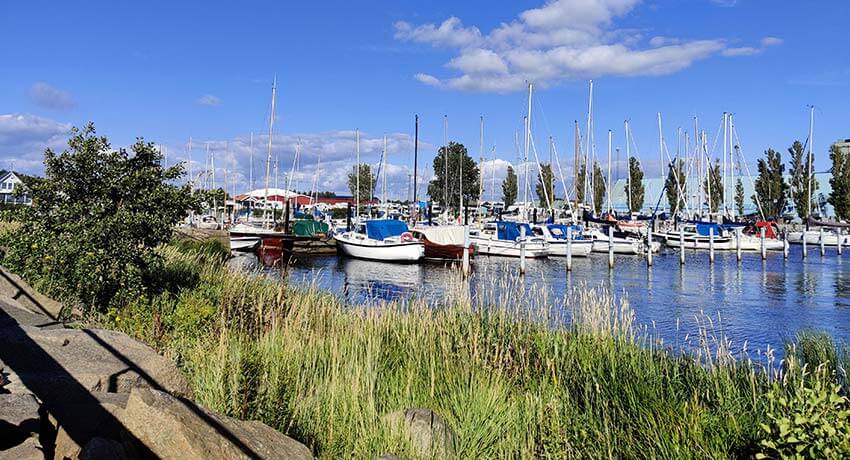
Marina at Nissan and Västra stranden
The quarry
The quarry came about because stone was necessary for piers in the harbours at the mouth of the Nissan river. In 1837, quarrying started at Kolhallsklippan. The quarry eventually filled with water and was soon popular for bathing. This was the origin of the present Simstadion Brottet (quarry swimming stadium), or Brottet (the quarry) as many Halmstad people call it.
Örnäsudden
Örnäsudden is forever associated with the Battle of Nissan, the largest sea battle of the Viking era. On 10 August 1062 the forces of Norway’s King Harald Hårdråde fought those of Denmark’s King Svend Estridsen.
Jansa quay
Jansa quay owes its existence to Gustav Jansson, manager of the Grötvik stone quarry. He started quarrying stone on his own land in 1899. To be able to ship the stone away, he commenced the building of a pier. Construction was stopped most probably because of the shallowness of the water at Grötvik. In 1972, concrete was poured to turn the pier into a bathing jetty. This latter is now very popular.
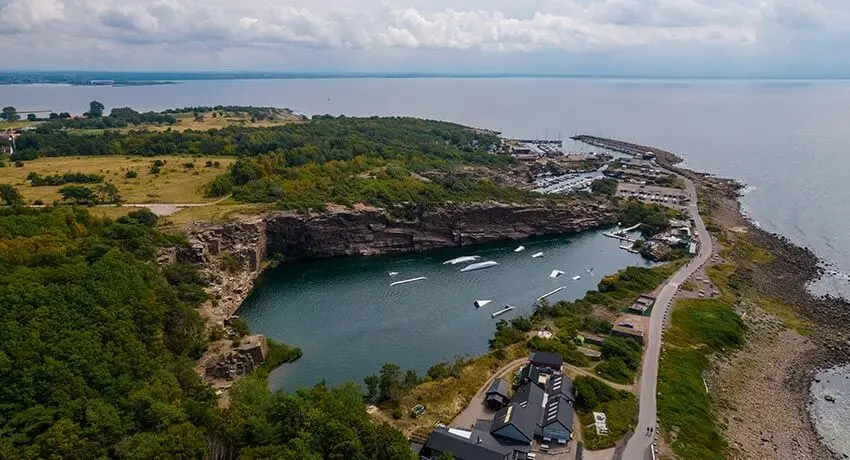
Grötvik. Photo: Joakim Leihed
Grötvik small-boat marina
The Grötvik small-boat marina was constructed from 1936 to 1939. It occupies the old quarry and was built by unemployed quarry workers. The name Grötvik probably comes from “gryta” (cooking pot). Grötvik’s harbour provides a natural and safe pot!
The king stone
Between Grötvik and Sandhamn, Kungastenen (the king stone) carries inscriptions of three kings. These are Oscar II, Gustaf VI Adolf and Carl XVI Gustaf. The inscriptions show that each of these visited the stone quarry at different times.
When Oscar II visited Söndrum in 1899 after hunting in Fammarp, he was in a bad mood. Instead of the union flag, which the king had expected, a red flag was flying at the community hall. He refused the offered refreshments and showed no interest at all in the work at the stone quarry.
There is also a king stone in Halmstad City. This one is an artwork depicting the meeting between Gustav II Adolf, king of Sweden, and Kristian IV, king of Denmark. It was created by Edvin Öhrström.
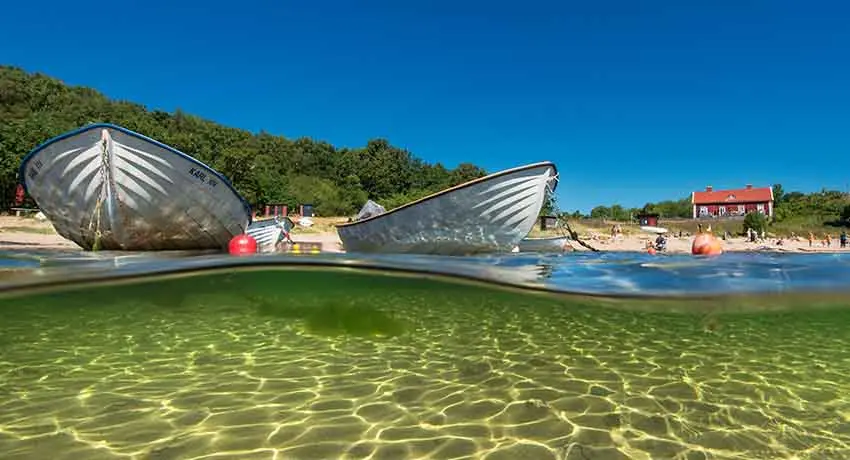
Tjuvahålan. Photo: Patrik Leonardsson
Tjuvahålan
At the end of the 18th century, Tjuvahålan (which could be translated as “thief hole”) became a landing place for smugglers. In 1850, the Carlsberg farmstead was built on the crest of Tjuvahålan. Twenty years later, a customs station was set up here and the crown’s officers moved in. The site was decommissioned from the 1920s onwards and demolished in 1979. Since the start of the 20th century, Tjuvahålan has been a popular bay for bathing.
St. Olof’s Chapel
St. Olof’s Chapel and its bell tower can be glimpsed from Prince Bertil’s trail. This beautiful wooden edifice was initially the parish church of Lidhult in Småland. However, it was dismantled in 1879 and its parts sent to all corners of the world. Through the outstanding detective work of Erik Salvén, a county custodian of antiquities, most of these parts were recovered and the chapel has been at its present site since 1950. In the summer, there is a café here and concerts are held. Please refer to our events calendar to see if there are any upcoming concerts.
Tylön island
Tylön takes its name from “tyle”, which means “protruding, rocky, headland”. On the island, there are Bronze Age stone mounds and the Tylajungfrun (“Tyle maiden”) menhir. The lighthouse designed by Gustaf von Heidenstam was built in 1870 along with dwellings for four lighthouse men and a teacher.
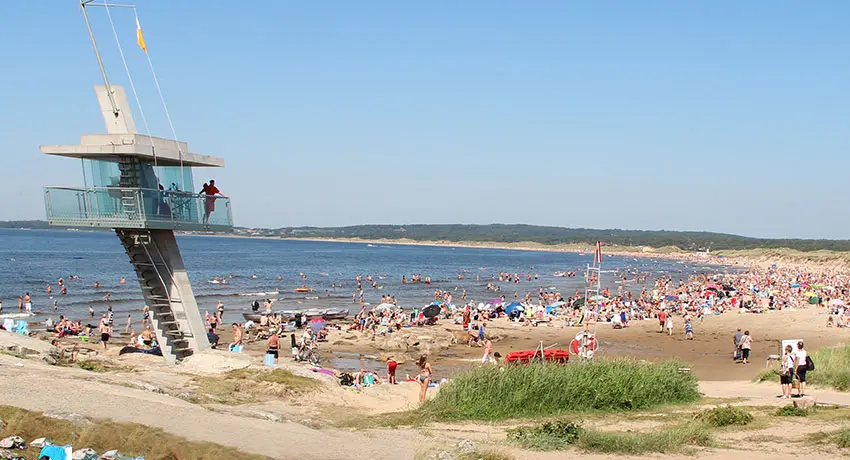
The lifeguard tower in Tylösand
Tylösand
Tylösand is one of Sweden’s best-known beaches. It was also one of the first to achieve blue-flag certification. This is recognition that it is clean, safe and tourist-friendly. Tylösand’s breakthrough years was 1929, when it started to assert itself as the beach resort of the upper class. Today, Hotel Tylösand is owned by Per Gessle and Björn Nordstrand. It houses Tres Hombres Art (an international collection of contemporary art) and a music museum.
The valley of the Tylö stream (Tylöbäckens dalgång)
In the spring, this valley is full of birdsong. The common redstart and blackcap sing in chorus here. However, they are drowned out by Sweden’s next smallest bird, the wren, which weighs no more than 5 grams. Ibex came here with the inland ice over 13,000 years ago.
The northern course
The northern course (Norre banan) is one of Halmstad Golf Club’s two courses in Tylösand. Their 36 holes are well-known to the world’s best players. When the first Tylösand golf course was opened in 1938, it was also Sweden’s first, complete, 18-hole facility. Prince Bertil teed off here many times over the years.
Möllegård’s mill
Möllegård’s mill was erected in the 1850s and has four floors. Two of these are residential and the others are devoted to milling. Pause a while at the mill pond, listen to the quietness and enjoy the reflections in the water.
